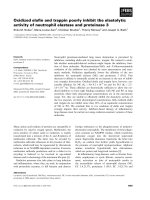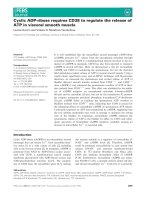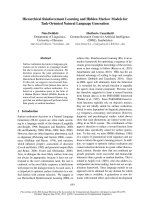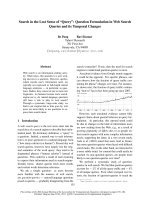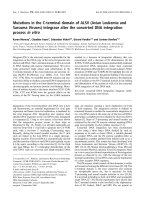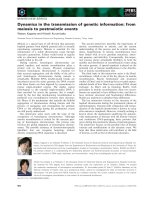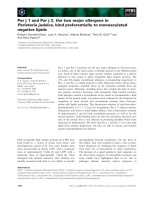Báo cáo khoa học: "Haemostatics in surgery and our experience in the enucleoresection of renal cell carcinoma" ppt
Bạn đang xem bản rút gọn của tài liệu. Xem và tải ngay bản đầy đủ của tài liệu tại đây (546.88 KB, 6 trang )
WORLD JOURNAL OF
SURGICAL ONCOLOGY
Pace et al. World Journal of Surgical Oncology 2010, 8:37
/>Open Access
TECHNICAL INNOVATIONS
BioMed Central
© 2010 Pace et al; licensee BioMed Central Ltd. This is an Open Access article distributed under the terms of the Creative Commons
Attribution License ( which permits unrestricted use, distribution, and reproduction in
any medium, provided the original work is properly cited.
Technical innovations
Haemostatics in surgery and our experience in the
enucleoresection of renal cell carcinoma
Gianna Pace*
1,2,3
, Pietro Saldutto
2,3
, Carlo Vicentini
2,3
and Lucio Miano
4
Abstract
Background: 30 patients, with T1 renal cell carcinomas (RCC) who underwent open enucleoresection of the tumour,
were randomized to the use of a topical haemostatic agent (Floseal) or to an infrared-sapphire coagulator (ISC), to
compare their efficacy in achieving haemostasis. Methods: Successful intra-operative haemostasis, intra- and post-
operative bleeding, operative time, hospital discharge were evaluated.
Results: Statistically higher rates of successful haemostasis and shorter time-to-haemostasis (8,1 vs 12,9 min) were
observed in the FloSeal group (p < 0.001 both). Patients operative time was not different between Group 1 vs 2 (58.7 ±
12 vs 62.4 ± 15; p > 0.05). The average blood loss during surgery was less (60 +/- 25.5 mL) for the FloSeal group than for
the ISC group (85 +/- 40.5 mL) (p < 0.05). Postoperative blood loss was 25 +/- 5 mL and 40 +/- 45 mL for Floseal and ISC
respectively, (p < 0.05). Length of the postoperative hospital discharge was 2.5 +/- 1.2 days for FloSeal group and 3.5 +/
- 1.3 for the Group 2 (p < 0.05). No major immediate or delayed complications were observed in either Groups.
Conclusions: The use of Floseal and ISC offer a safe and efficacy haemostasis in the enucleoresection of RCC. Moreover,
our results show a less intra-operative and post-operative blood loss as well as a shorter time to haemostasis of Floseal
in respect to ISC.
Background
As the number of minimally invasive and laparoscopic
procedures increases, haemostatic agents (HAs) are
becoming more popular as a means of achieving rapid
haemostasis. Although the recently widespread accep-
tance, confusion still persists about their indications for
use and the optimal agent choice. They comprise a wide
range of components including topical hemostats, anti-
fibrinolytics, fibrin sealants and matrix hemostats. Topi-
cal HAs composed of a gelatin-based matrix and throm-
bin have been reported to be effective, in addition to
traditional means, in terminating bleeding during cardiac
operations in comparison with haemostatic patches or
sponges composed of either oxidized regenerated cellu-
lose or purified porcine skin gelatin [1]. The haemostatic
efficacy and handling of gelatin-thrombin matrix has
been proven also in the uterine bleeding, during abdomi-
nal myomectomy and, in thyroid surgery [2-5]. Adequate
haemostasis is extremely important in neurosurgery. In
patients with supratentorial intracerebral hematomas
FloSeal, injected into the surgical cavity, has reduced
brain exposure, damage to the surrounding tissue and the
length of surgery. Furthermore, application of FloSeal at a
laminectomy site may be useful to decrease adhesion at
the interface between the dura mater and the epidural
fibrosis [6,7]. Moreover, the management of intradural
bleeding during extended endoscopic endonasal surgery
has been challenged by applying a thrombin-gelatin hae-
mostatic matrix, useful for both oozing and focal hemor-
rhage and effective even for high-flow bleeding [8].
Recently, Izzo et al. reported a large prospective study
with the use of HAs in patients undergoing major hepatic
surgery providing a rapid and effective intra-operative
control of mild to severe bleeding from the liver edge [9].
In animal models, comparing safety, efficacy, presence of
residual material and foreign body reaction of commonly
used agents such as microporous polysaccharide hemo-
spheres (Arista), oxidized cellulose (Surgicel), microfibril-
lar collagen (Avitene) and gelatin matrix thrombin
sealant (FloSeal) emerged that Arista, Avitene, FloSeal,
and Surgicel performed better haemostasis; residual
material was not present with Arista, contrasting with its
* Correspondence:
1
Department of Surgical Sciences, University of L'Aquila, San Salvatore Street,
Palace 6 A, Coppito, 67100 L'Aquila, Italy
Full list of author information is available at the end of the article
Pace et al. World Journal of Surgical Oncology 2010, 8:37
/>Page 2 of 6
presence in 100% of lesions using Avitene, FloSeal, and
Surgicel; furthermore Avitene and FloSeal demonstrated
a propensity for causing granuloma formation, whereas
Arista and Surgicel showed no such evidence. Arista
degrades more rapidly than Surgicel, Avitene and FloSeal
and it does not result in any foreign body reaction [10].
Focusing on the urologic applications of tissue glues
and HAs, they have been used in the management of gen-
itourinary injuries, surgical wounds, and complications.
The best evidence for efficacy and safety exists for hae-
mostasis, especially for nephrectomy and trauma. Newer
data highlight urinary tract reconstruction, fistula and
percutaneous tract closure, suture line strengthening and
infertility as potential uses.
Partial nephrectomy (PN) is a procedure frequently
reserved for small, peripherally located renal tumours
and the intra- and post-operative haemorrhage repre-
sents the most significant risk associated to surgery.
Based upon such considerations and as HAs have
become increasingly employed across all surgical fields,
we aim to compare the safety and efficacy of a haemo-
static matrix sealant agent, FloSeal with an infrared-sap-
phire coagulator (ISC), during open enucleoresection of
renal cell carcinoma (RCC), to minimize or avoid sutur-
ing and warm ischemia time.
Methods
From January 2006 and June 2009 all patients affected by
a RCC were considered for this study. Of these, we
enrolled only who has been selected to undergo a lumbar
renal enucleoresection. Criteria required for performing
an enucleoresection were a peripheral RCC with a diame-
ter less or equal to 4 cm (stage T1a) [11]. Enucleoresec-
tion means to remove the tumor and its pseudocapsule
with a normal renal parenchyma margin. With a blunt
dissection by using monopolar electrocautery, the cap-
sule of the tumour was incised circular about 5 mm
around and the mass removed. The same surgeon per-
formed all operations by a lumbar access.
Of 38 eligible patients, 8 declined to participate in the
study and a total of 30 subjects were enrolled. The
research has been carried out in accordance with the
Declaration of Helsinki and approved by the Ethics Com-
mittee of our hospital. Consent was obtained from all
patients after full explanation of the procedure. Patients
were randomly assigned to one of the two haemostatic
approaches: 15 (Group 1) to FloSeal (5,000 U/5 mL) (Bax-
ter Inc, Deerfield, IL) and 15 (Group 2) to ISC (Saphir-
Koagulator ISK 250, NK-OPTIK, München). Randomiza-
tion number was assigned by using a random allocation
software.
Before surgical treatment, subjects were evaluated with
a detailed history, physical examination, standard blood
chemical analyses, upper urinary tract and bladder ultra-
sound, abdomen computerized tomography without and
with intravenous contrast medium.
FloSeal is composed of a bovine-derived gelatin matrix
component and of a human-derived thrombin compo-
nent; it works on wet, actively bleeding tissue. After iden-
tifying the source of bleeding at the tissue surface,
manually a gauze sponge is approximated against the
bleeding surface and with the applicator tip Floseal is
applied between the sponge and the bleeding surface to
create a small hill at the source of bleeding. The gauze
sponge holds Floseal in place, against the bleeding sur-
face. To minimize disruption of the clot, the gauze
sponges is removed after hemostasis has been achieved.
ISC works through the conversion of light into thermal
energy upon absorption by the bleeding tissue causes
coagulation and haemostasis. By the ISC, light (wave
length: 0.4-3 μm, power: 120W) from a halogen lamp is
being transmitted to the bleeding tissue via a sapphire
crystal, which is non-adhesive and of high thermal resis-
tance. ISC is focused against the bleeding surface as long
is necessary to achieve haemostasis.
The study endpoints for the evaluation of haemostatic
efficacy were the rate of successful intra-operative hae-
mostasis (identified by cessation of bleeding) and time
required for haemostasis, overall post-operative bleeding,
rate of transfusion, rate of surgical revision for bleeding
and post-operative morbidity, were evaluated. The out-
come measures were the patient's operative time, blood
loss, intra-operative and post-operative complications,
and length of hospitalization.
SPSS for Windows (version 10.0.7) computer package
was used for statistical analysis. In order to detect a dif-
ference of 30% between the 2 groups in the effect size
(two-side type I error of 5% and type II error of 0.2%) 30
patients were necessary. Statistical significance was
accepted if p < 0.05. All statistical tests were two-tailed.
As variables were not normally distributed (Shapiro-Wilk
test; P < 0.05) continuous variables were analyzed with
Wilcoxon-Mann Whitney Rank Sum Test. Categorical
variables between groups were compared with Chi-
square test or with Fisher's exact test when requested.
Results
17 men and 13 women with a median age of 52.5 years
(Group 1 vs 2; p > 0.05), were enrolled. In Table 1 we
report the demographic characteristics and preoperative
parameters of patients enrolled. As showed in the com-
puterized tomography, the depth of penetration of
tumors ranged from 1 to 3 cm (median 1,9 cm), without a
direct contact with the upper excretory urinary tract
(renal pelvis) in each of the patients enrolled. The tumor
diameter ranged from 2.0 to 4.0 cm (median 3.3 cm), in
both groups (p > 0.05). Renal hilar clamping was not
required. Excision was performed with a monopolar elec-
Pace et al. World Journal of Surgical Oncology 2010, 8:37
/>Page 3 of 6
trocautery, and final haemostasis was obtained with
FloSeal (Group 1) or with ISC (Group 2), without sutur-
ing. Statistically higher rates of successful haemostasis
and shorter time-to-haemostasis (8,1 vs 12,9 min) were
observed in the FloSeal group (p < 0.001 both) (Table 2).
Patients operative time was not different between Group
1 vs 2 (58.7 vs 62.4; p > 0.05). The average blood loss dur-
ing surgery was less for the FloSeal group than for the ISC
group (60 vs 85 mL; p < 0.05). Postoperative median
blood loss through the Jackson-Pratt drain was 25 mL for
the FloSeal group and 46 mL for the control group (p <
0.05). In addition, wound drain removal occurred earlier,
the day after surgery, with FloSeal (p = 0.04 vs. group 2).
Transfusion of blood products and revision for bleeding
were not required. Median length of the postoperative
hospital discharge was 2.5 days for FloSeal group and 3.5
for the Group 2 (p < 0.05). Patients' discharge and
removal of drains has been decided by the clinicians
blinded to the treatment allocation.
No major immediate or delayed complications were
observed in either Groups. Pathology revealed a 90% of
clear cell RCC, 8% of papillary and 2% of chromophobe
RCC (Group 1 vs 2; p > 0.05). All margins of resection
were negative. At a mean follow-up of 15 months (6-37
months) no recurrence was observed. Among all patients,
the mean preoperative serum creatinine was 0.9 mg/dL,
and the average level at a mean of 12 months postopera-
tively was 1.0 mg/dL (Group 1 vs 2; p > 0.05).
Discussion
Topical HAs are classified by the FDA as absorbable or
non-absorbable, or as sealants (liquid adhesives) and
dressing (solid matrix) [12]. As it should be hard to con-
duct clinical trials on the use of HAs in several different
surgical fields due to the individual variability of patients,
there are not defined indications as regard their efficacy
and safety and about how to choose the appropriate hae-
mostatic. Several studies have been carried on to investi-
gate the haemostatic capacity and stability of different
HAs like gelatin (sponge and matrix), bovine thrombin,
freeze-dried recombinant factor VIIa and microporous
polysaccharide hemispheres, in experimental traumatic
bleeding models) [13]. The reduction in blood loss after
liver injury and in a grade 5 renal injury, with no delayed
Table 2: Intra-operative and post-operative results
Group 1 Group 2 P values
Operative time (min) 58.7 (46.7-70.7) 62.4 (47.4-77.4) >0.05
2
Time to haemostaisis (min) 8,1 (7-9.1) 12,9 (10.7-15) <0.001
2
Intraoperative blood loss (mL) 60 (34.5-85.3) 85 (44.3-125.2) <0.05
2
Postoperative blood loss (mL) 25 (23.3-50.1) 46 (35.3-90.2) <0.05
2
Drain removal (days) 1 (1-2) 3 (1-4) 0.04
2
Hospital discharge (days) 3 (2-4) 4 (4-6) <0.05
2
1
χ
2
corrected test or Fisher's Exact test;
2
Wilcoxon-Mann Whitney Rank Sum Test.
Table 1: Demographic and pre-operative parameters of patients enrolled
Group 1 (15 patients) Group 2 (15 patients) P values
Age (years) 51 (39-62) 53 (40-65) 0.26
2
Gender n (%) Male 8 (53%)
Female 7 (47%)
Male 9 (60%)
Female 6 (40%)
0.08
1
0.09
1
Depth of penetration of tumors in renal parenchyma 1.9 (0.8-3.0) 1.9 (1.0-2.9) 0.90
2
Tumor diameter 3.3 (2.4-4.1) 3.3 (2.1-4.5) 0.94
2
1
χ
2
corrected test or Fisher's Exact test;
2
Wilcoxon-Mann Whitney Rank Sum Test.
Pace et al. World Journal of Surgical Oncology 2010, 8:37
/>Page 4 of 6
bleeding and nephrotoxicity, suggests a possible employ
for FloSeal in the treatment of devastating renal injuries
[14,15]. Furthermore, a porcine model investigating on
the use of FloSeal and Tisseel in vascular and collecting-
system injury during partial nephrectomy has showed
that Tisseel alone is not adequate for either haemostasis
or management of major collecting-system injury, while
Floseal appears sufficient to control major vascular and
collecting-system injuries [16]. All those studies paved
the way for a large use of the aforementioned sealants in
several surgical fields. In the urologic surgery, Floseal has
been used for tubeless percutaneous nephrolithotomy in
patients rendered completely stone free, administrating
the haemostatic gelatin matrix to the nephrostomy tract,
achieving immediate haemostasis and avoiding the place-
ment of a nephrostomy tube [17,18]. With increasing sur-
gical skills and novel methods of haemostasis,
laparoscopic PN (LPN) has become an attractive treat-
ment option for selected renal tumors [19,20]. In per-
forming LPN, FloSeal and BioGlue have been proposed to
avoid surgical bolsters or parenchymal sutures and to
make more surgeons comfortable with the intricacies of
laparoscopic suturing [21,22]. A recent survey on the cur-
rent practice for urologists performing LPN, confirmed
that HAs and/or glues were used in 77.4% of cases and
were mainly represented by gelatin matrix thrombin
(FloSeal), fibrin gel (Tisseel), bovine serum albumin (Bio-
Glue), cyanoacrylate glue (Glubran), oxidized regener-
ated cellulose (Surgicel), or combinations of these. The
overall postoperative bleeding requiring transfusion and
urine leakage rates were 2.7% and 1.9%, respectively [23-
29].
The widespread use of modern radiological techniques
substantially changed clinical presentation of RCC in the
last decades and, more than one half of all patients with
surgically localized renal tumors are detected inciden-
tally. All this lead to an increased interest in nephron-
sparing surgery (NSS) for the treatment of small tumors.
Enucleoresection is one of the NSS techniques available
for the elective treatment of small RCC in stage T1a,
allowing long-term cancer specific survival rates without
an increased risk of local recurrence. We have chosen to
perform the enucleoresection in a selected group of
patients comparing two ways of achieving haemeostasis
by FloSeal and ISC, in the attempt to verify differences
related to time to haemostasis, blood loss, operative time
and to spare or avoid renal parenchymal damage by heat
and suturing. Our results were in accord with those
reported in the current literature [30]. By applying Floseal
during open enucleoresection of RCC, bleeding was effi-
ciently controlled in all patients treated and none
required post-operative transfusions or showed signifi-
cant post-operative blood loss. Mostly important we
compared the haemostatic efficiency of Floseal with the
unusual application in the kidney surgery of ISC. ISC has
been developed for the haemostasis of parenchymatous
haemorrhage, mainly liver and spleen, showing that the
time until haemostasis takes place was reduced 60% and
depth of necrosis 25% in comparison to usual diathermia.
Also by using the ISC, we achieved good results in term
of bleeding control even if with longer time to haemosta-
sis respect to FloSeal and a greater intra-operative blood
loss. HAs like Floseal, used in the enucleresection of
RCC, offer a good haemostatic control without the need
of suturing. This suggestion is supported by our experi-
ence as we reached a satisfying haemostasis by applying
the HA all over the wound ground or by using the infra-
red light on the bleeding sites.
Based on more recent data, FloSeal has been experi-
mented in the robotic laparoscopic radical prostatectomy
(RP) in the attempt to develop techniques cautery-free,
clip-free and nerve-sparing that preserve the neurovascu-
lar bundles and minimize trauma, even if the effect on
potency still needs further follow-up [31,32].
As the indications for topical HAs increase in urology,
the question arises about what happens to these agents
when they enter the urinary collecting system. It has been
shown that fibrin glue and oxidized regenerated cellulose
maintain a solid form when initially placed in direct con-
tact with urine and then assume a semisolid gelatinous
state. Polyethylene glycol forms a solid clot initially and
does not change after 5 days. Only hemostatic gelatin
matrix remained as a fine particulate suspension in both
normal and sanguineous urine so that the implications of
these findings with regard to sealing the renal paren-
chyma or the collecting system are still to be evaluated
[33]. Nonetheless, nowadays the haemostatic agents are
still expensive so that it has been proposed their use in
major surgical procedures and in acute life-threatening
hemorrhages or otherwise in moderately critical patients
with severe concomitant diseases or coagulation disor-
ders. The cost of the kit of Floseal is in US 85 dollars. Dif-
ferently from Floseal the ISC is an equipment which,
although more expensive at the beginning, allow to treat
several patients even if with longer time to haemostasis
according to our results. Also adverse events have been
reported in several fields as consequence of the use of gel-
atin-thrombin. HAs may elicit a foreign body reaction
leading to large giant cell granuloma, mimicking a meta-
static disease [34,35]. HAs, frequently used during
abdominal surgery, are linked to adhesion formation: a
case of early post-operative small bowel obstruction dur-
ing laparoscopic staging for endometrial cancer has been
described, underling that the use of haemostatic agents
should be considered as a cause in the differential diagno-
sis in patients with early post-operative bowel obstruc-
tion [36-38]. Not the least, application of FloSeal in the
lumpectomy cavity has resulted in benign mammogra-
Pace et al. World Journal of Surgical Oncology 2010, 8:37
/>Page 5 of 6
phyc microcalcifications that could be misinterpreted as
malignant [39]. Therefore, it is crucial to get a better
understanding of the genesis of those reactions.
Ahead of its time are, on one hand, the recently applica-
tions of HAs in the premature rupture of membranes
where the adhesive sealants confer mechanical support to
the membrane and form a water tight seal [40]. On the
other hand, in the prostate cancer research frontiers, has
been evaluated the potential use of intra-operative gelatin
matrix haemostatic sealant embedded with macrophages
transduced with murine interleukin 12 recombinant ade-
noviral vector for prevention of recurrence of prostate
cancer following RP [41].
To our knowledge this is the first study which compare
the use of a HA and of the ISC in the enucleoresection of
RCC. The recent evidence related to the NSS capable, in
selected cases, to offer the same results of partial and rad-
ical nephrectomy as regard the overall cancer-specific
survival and the progression free survival, open the way
to look for minimally invasive approach without the
necessity of renal hilar clamping, avoiding the risks
related to warm ischemia time. Bleeding of the kidney
wound is usually controlled by bipolar coagulation and by
suturing, potentially increasing the induced tissue dam-
age by heat and by sutures. According with our results, it
should be easily achieved, in selected patients with RCC
of limited dimension, by using topic HAs or the ISC.
Overall, in our procedure also the need of suturing was
not required minimizing the operative time without any
risk of further intra- or post- operative bleeding. Even if,
it has been reported the use of thrombin-gelatin haemo-
static matrix for both oozing and focal hemorrhage and
effective even for high-flow bleeding, according with our
experience, we suggest to apply HAs to control localized
bleeding, for tumors of 7 cm or less of diameter. We pro-
pose to make use of those different way of achieving hae-
mostasis considering the satisfying results, their handling
and their efficacy, in the enucleoresecton of RCC looking
to a further employ also in the nerve sparing RRP. Never-
theless, those haemostatics should also result in more
patients, suffering from several comorbidities with conse-
quence coagulation disorders, being able to undergo min-
imally invasive NSS. Even if we agree that HAs is the way
to go, they are not free from adverse reactions such as the
creation of inflammation and necrosis with the risk of
adhesions formation, whose genesis need to be clarified
and which claim further studies to improve the design of
these agents in future. Moreover, additional investiga-
tions will clarify the indications and the best HAs to
choose.
Looking to the future, minimally invasive surgery will
further drive the use of topical HA in the urologic field.
They offer promising employ in the laparoscopic and
robotic surgery to avoid the intricacy of the laparoscopic
sutures, to achieve rapidly hemostat in life-risk hemor-
rhages in complicate situations like during wars or in
patients with an altered coagulation status.
Conclusions
Our results show Floseal and ISC to be both safe and effi-
cacy in achieving haemostasis in the enucleoresection of
RCC in T1a stage, with a less intra-operative and post-
operative blood loss as well as a shorter time to haemo-
stasis of Floseal in respect to ISC.
Competing interests
The authors declare that they have no competing interests.
Authors' contributions
GP and CV have made contribution to conception and design, drafting and
revising the manuscript, PS has acquired data and revising manuscript. All
authors have contributed to analyse, interpret and approved the version to be
published.
Author Details
1
Department of Surgical Sciences, University of L'Aquila, San Salvatore Street,
Palace 6 A, Coppito, 67100 L'Aquila, Italy,
2
Department of Health Sciences,
University of L'Aquila, San Salvatore Street, Palace 6 A, Coppito, 67100 L'Aquila,
Italy,
3
Department of Urology, Mazzini Hospital, Italy Square, Teramo, Italy and
4
Department of Urology, Sant'Andrea Hospital, University La Sapienza, Rome,
Italy
References
1. Nasso G, Piancone F, Bonifazi R, Romano V, Visicchio G, De Filippo CM,
Impiombato B, Fiore F, Bartolomucci F, Alessandrini F, Speziale G:
Prospective, Randomized Clinical Trial of the FloSeal Matrix Sealant in
Cardiac Surgery. Ann Thorac Surg 2009, 88:1520-6.
2. Raga F, Sanz-Cortes M, Bonilla F, Casañ EM, Bonilla-Musoles : Reducing
blood loss at myomectomy with use of a gelatin-thrombin matrix
hemostatic sealant. Fertil Steril 2009, 92:356-60.
3. Testini M, Marzaioli R, Lissidini G, Lippolis A, Logoluso F, Gurrado A, Lardo
D, Poli E, Piccinni G: The effectiveness of FloSeal matrix hemostatic
agent in thyroid surgery: a prospective, randomized, control study.
Langenbecks Arch Surg 2009, 394:837-42.
4. Ebert AD, Hollauer A, Fuhr N, Langolf O, Papadopoulos T: Laparoscopic
ovarian cystectomy without bipolar coagulation or sutures using a
gelantine-thrombin matrix sealant (FloSeal): first support of a
promising technique. Arch Gynecol Obstet 2009, 280:161-5.
5. Angioli R, Muzii L, Montera R, Damiani P, Bellati F, Plotti F, Zullo MA, Oronzi
I, Terranova C, Panici PB: Feasibility of the use of novel matrix hemostatic
sealant (FloSeal) to achieve hemostasis during laparoscopic excision of
endometrioma. Minim Invasive Gynecol 2009, 16:153-6.
6. Gazzeri R, Galarza M, Neroni M, Alfieri A, Esposito S: Minimal craniotomy
and matrix hemostatic sealant for the treatment of spontaneous
supratentorial intracerebral hemorrhage. J Neurosurg 2009, 110:939-42.
7. Dogulu F, Durdag E, Cemil B, Kurt G, Ozgun G: The role of FloSeal in
reducing epidural fibrosis in a rat laminectomy model. Neurol Neurochir
Pol 2009, 43:346-51.
8. Cappabianca P, Esposito F, Esposito I, Cavallo LM, Leone CA: Use of a
thrombin-gelatin haemostatic matrix in endoscopic endonasal
extended approaches: technical note. Acta Neurochir 2009, 151:69-77.
9. Izzo F, Di Giacomo R, Falco P, Piccirillo M, Iodice R, Orlando AP, Aprea P,
Cremona F, Di Marzo M, Idà DN, Mastro AA, Curley SA: Efficacy of a
haemostatic matrix for the management of bleeding in patients
undergoing liver resection: results from 237 cases. Curr Med Res Opin
2008, 24:1011-1015.
10. Ereth MH, Schaff M, Ericson EF, Wetjen NM, Nuttall GA, Oliver WC Jr:
Comparative safety and efficacy of topical hemostatic agents in a rat
neurosurgical model. Neurosurgery 2008, 63(4 Suppl 2):369-72.
Received: 24 February 2010 Accepted: 12 May 2010
Published: 12 May 2010
This article is available from: 2010 Pace et al; licensee BioMed Central Ltd. This is an Open Access article distributed under the terms of the Creative Commons Attribution License ( which permits unrestricted use, distribution, and reproduction in any medium, provided the original work is properly cited.World Journal of Surgical Oncology 2010, 8:37
Pace et al. World Journal of Surgical Oncology 2010, 8:37
/>Page 6 of 6
11. Ljungberg B, Hanbury DC, Kuczyk MA, Merseburger AS, Mulders PFA,
Patard JJ, Sinescu IC: European Association of Urology Guideline Group
for renal cell carcinoma. Renal cell carcinoma guideline. Eur Urol 2007,
51:1502-10.
12. Kulkarni R: Alternative and topical approaches to treating the massively
bleeding patient. Clinical advances in hematology and oncology 2004,
2:428-31.
13. Björses K, Holst J: Topical haemostatics in renal trauma an evaluation of
four different substances in an experimental setting. J Trauma 2009,
66:602-11.
14. Klemcke HG: Evaluation of FloSeal as a potential intracavitary
hemostatic agent. J Trauma 2006, 60:385-9.
15. Pursifull NF, Morris MS, Harris RA, Morey AF: Damage control
management of experimental grade 5 renal injuries: further evaluation
of FloSeal gelatin matrix. J Trauma 2006, 60:346-50.
16. L'Esperance JO, Sung JC, Marguet CG, Maloney ME, Springhart WP,
Preminger GM, Albala DM: Controlled survival study of the effects of
Tisseel or a combination of FloSeal and Tisseel on major vascular injury
and major collecting-system injury during partial nephrectomy in a
porcine model. J Endourol 2005, 19:1114-21.
17. Kaufmann OG, Sountoulides P, Kaplan A, Louie M, McDougall E, Clayman
R: Skin treatment and tract closure for tubeless percutaneous
nephrolithotomy: University of California, Irvine, technique. J Endourol
2009, 23:1739-41.
18. Borin JF, Sala LG, Eichel L, McDougall EM, Clayman RV: Tubeless
percutaneous nephrolithotomy using hemostatic gelatin matrix. J
Endourol 2005, 19:614-7. discussion 617
19. Wille AH, Tüllmann M, Roigas J, Loening SA, Deger S: Laparoscopic partial
nephrectomy in renal cell cancer results and reproducibility by
different surgeons in a high volume laparoscopic center. Eur Urol 2006,
49:337-42. discussion 342-3
20. Zorn KC, Gong EM, Orvieto MA, Gofrit ON, Mikhail AA, Shalhav AL: Impact
of collecting-system repair during laparoscopic partial nephrectomy. J
Endourol 2007, 21:315-20.
21. Madi R, Wolf JS Jr: Single-setting bilateral hand-assisted laparoscopic
partial nephrectomy. J Endourol 2009, 23:929-32.
22. Nadler RB, Perry KT, Smith ND: Hybrid laparoscopic and robotic
ultrasound-guided radiofrequency ablation-assisted clampless partial
nephrectomy. Urology 2009, 74:202-5.
23. Breda A, Stepanian SV, Lam JS, Liao JC, Gill IS, Colombo JR, Guazzoni G,
Stifelman MD, Perry KT, Celia A, Breda G, Fornara P, Jackman SV, Rosales A,
Palou J, Grasso M, Pansadoro V, Disanto V, Porpiglia F, Milani C, Abbou CC,
Gaston R, Janetschek G, Soomro NA, De la Rosette JJ, Laguna PM, Schulam
PG: Use of haemostatic agents and glues during laparoscopic partial
nephrectomy: a multi-institutional survey from the United States and
Europe of 1347 cases. Eur Urol 2007, 52:798-803.
24. Derweesh IH, Malcolm JB, Diblasio CJ, Mehrazin R, Jackson S: Sutureless
laparoscopic heminephrectomy: safety and efficacy in physiologic and
chronically obstructed porcine kidney. Surg Innov 2008, 15:194-202.
25. Guzzo TJ, Pollock RA, Forney A, Aggarwal P, Matlaga BR, Allaf ME: Safety
and efficacy of a surgeon-prepared gelatin hemostatic agent
compared with FloSeal for hemostasis in laparoscopic partial
nephrectomy. J Endourol 2009, 23:279-82.
26. Abraham JB, Gamboa AJ, Finley DS, Beck SM, Lee HJ, Santos RJ, Box GN,
Deane LA, Vajgrt DJ, McDougall EM, Clayman RV: The UCI Seldinger
technique for percutaneous renal cryoablation: protecting the tract
and achieving hemostasis. J Endourol 2009, 23:43-9.
27. Celia A, Zeccolini G, Guazzoni G, Pansadoro V, Disanto V, Porpiglia F, Milani
C, Abbou C, Gaston R, Janetschek G, Soomroo NA, Fornara P, Breda A,
Schulam PG, De la Rosette J, Laguna MP, Palou J, Breda G: Laparoscopic
nephron sparing surgery: a multi-institutional European survey of 592
cases. Arch Ital Urol Androl 2008, 80:85-91.
28. Ho H, Schwentner C, Neururer R, Steiner H, Bartsch G, Peschel R: Robotic-
assisted laparoscopic partial nephrectomy: surgical technique and
clinical outcomes at 1 year. BJU Int 2009, 103:663-8.
29. Rouach Y, Delongchamps NB, Patey N, Fontaine E, Timsit MO, Thiounn N,
Méjean A: Suture or hemostatic agent during laparoscopic partial
nephrectomy? A randomized study using a hypertensive porcine
model. Urology 2009, 73:172-7.
30. Gong EM, Zorn KC, Gofrit ON, Lucioni A, Orvieto MA, Zagaja GP, Shalhav
AL: Early laparoscopic management of acute postoperative
hemorrhage after initial laparoscopic surgery. J Endourol 2007,
21:872-8.
31. Ahlering TE, Eichel L, Chou D, Skarecky DW: Feasibility study for robotic
radical prostatectomy cautery-free neurovascular bundle
preservation. Urology 2005, 65:994-7.
32. Zeltser I, Dugi D, Gupta A, Park S, Kabbani W, Cadeddu J: Does topical
haemostatic agent have an adverse effect on the function of the
prostatic neurovascular bundle? BJU Int 2008, 102:1005-7.
33. Uribe CA, Eichel L, Khonsari S, Finley DS, Basillote J, Park HK, Li CC,
Abdelshehid C, Lee DI, McDougall EM, Clayman RV: What happens to
hemostatic agents in contact with urine? An in vitro study. J Endourol
2005, 19:312-7.
34. Shashoua AR, Gill D, Barajas R, Dini M, August C, Kirschenbaum GL,
Escuardro L: Caseating granulomata caused by hemostatic agent
posing as metastatic leiomyosarcoma. JSLS 2009, 13:226-8.
35. Buchowski JM, Bridwell KH, Lenke LG, Good CR: Epidural spinal cord
compression with neurologic deficit associated with intrapedicular
application of hemostatic gelatin matrix during pedicle screw
insertion. Spine 2009, 34:473-7.
36. Hobday CD, Milam MR, Milam RA, Euscher E, Brown J: Postoperative small
bowel obstruction associated with use of hemostatic agents. J Minim
Invasive Gynecol 2009, 16:224-6.
37. Hoffmann NE, Siddiqui SA, Agarwal S, McKellar SH, Kurtz HJ, Gettman MT,
Ereth MH: Choice of hemostatic agent influences adhesion formation in
a rat cecal adhesion model. J Surg Res 2009, 155:77-81.
38. Thomas PJ, Tawfic SN: Eosinophil-rich inflammatory response to FloSeal
hemostatic matrix presenting as postoperative pelvic pain. Am J Obstet
Gynecol 2009, 200:10-1.
39. Henkel A, Cooper RA, Ward KA, Bova D, Yao K: Malignant-appearing
microcalcifications at the lumpectomy site with the use of FloSeal
hemostatic sealant. AJR Am J Roentgenol 2008, 191:1371-3.
40. Carnaghan HK, Harrison MR: Presealing of the chorioamniotic
membranes prior to fetoscopic surgery: preliminary study with
unfertilized chicken egg models. Eur J Obstet Gynecol Reprod Biol
2009:144 Suppl 1: S142-5.
41. Tabata K, Watanabe M, Naruishi K, Edamura K, Satoh T, Yang G, Abdel
Fattah E, Wang J, Goltsov A, Floryk D, Soni SD, Kadmon D, Thompson TC:
Therapeutic effects of gelatin matrix-embedded IL-12 gene-modified
macrophages in a mouse model of residual prostate cancer. Prostate
Cancer Prostatic Dis 2009, 12:301-9.
doi: 10.1186/1477-7819-8-37
Cite this article as: Pace et al., Haemostatics in surgery and our experience
in the enucleoresection of renal cell carcinoma World Journal of Surgical
Oncology 2010, 8:37
